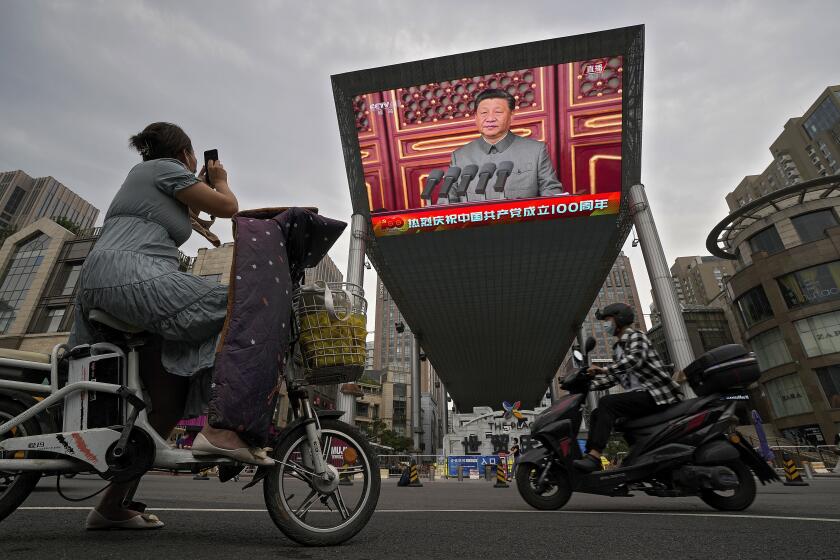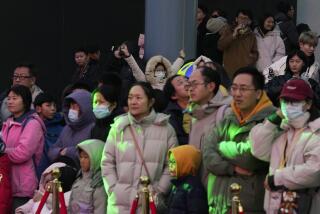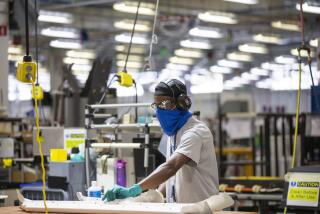China’s economic growth weakens amid construction slowdown

- Share via
BEIJING — China’s economic growth sank in the latest quarter, as a construction slowdown and official curbs on energy use by factories weighed on the nation’s recovery from the pandemic.
In the three months to September, the world’s second-largest economy grew by 4.9% over the same period last year. The previous quarter’s growth was 7.9%, government data showed Monday. Factory output, retail sales and investment in construction and other fixed assets all weakened.
Growth is under pressure from government controls aimed at making the energy-hungry economy more efficient and at reducing reliance on debt that Chinese leaders worry is dangerously high and could cause financial problems. Manufacturing has been hampered by shortages of processor chips and other components due to the pandemic.
Compared with the previous quarter, the way other major economies are measured, output in the July-to-September period barely grew, expanding by 0.2%. That was down from the April-to-June period’s 1.2% and one of the weakest quarters of the past decade.
As the economy slows, China’s crackdown on the rich and famous may be an attempt to distract from ordinary families’ anxiety over their children’s future.
“Growth will slow further,” Louis Kuijs of Oxford Economics said in a report. He said “ugly growth numbers” in coming months are likely to prompt Beijing to ease lending controls and try to prop up activity by encouraging infrastructure development.
Construction, an industry that supports millions of jobs, has slowed since regulators last year tightened control over borrowing by developers.
One of the biggest developers, Evergrande Group, is struggling to avoid defaulting on billions of dollars owed to bondholders. That has fueled fears about the health of other developers, though economists say the threat to global financial markets is small.
Manufacturing also was hampered in September by power cuts imposed by some major provinces to avoid exceeding official efficiency goals.
Factory output barely grew in September, expanding by 0.05% compared with August. That was down from 7.3% growth for the first nine months of the year.
Private-sector forecasters have cut their growth outlook this year for China, though they still expect about 8%, which would be among the world’s strongest. The ruling Communist Party’s official target is “more than 6%,” which leaves Beijing room to keep its controls in place.
China Evergrande is struggling with more than $300 billion in debt. At its Shenzhen headquarters, angry suppliers and investors demand overdue pay.
“The near-term outlook for China’s economy in Q4 remains difficult, due to the expected impact of continuing power shortages going into the winter season and a continuing slowdown in the property sector,” Rajiv Biswas of IHS Market said in a report. “The real estate sector continues to be hit by uncertainties relating to the Evergrande debt problems and fears of contagion to some other property developers.”
This year’s economic figures have been exaggerated due to comparison with 2020, when factories and stores were closed to fight the coronavirus.
The economy grew by a record 18.3% in the first quarter of 2021, but forecasters said the rebound already was leveling off.
In September, growth in retail spending weakened to 4.4% over a year earlier, down from 16.4% in the first nine months.
Investment in real estate, factories, housing and other fixed assets rose 0.17% in September, down from 7.3% for the first nine months.
Auto sales in the global industry’s biggest market fell 16.5% in September from a year earlier, according to the China Assn. of Automobile Manufacturers. The group said production was disrupted by shortages of processor chips.
Imports, an indicator of Chinese domestic demand, rose 17.6% in September from a year earlier, but that was barely half the previous month’s 33% growth.
More to Read
Sign up for Essential California
The most important California stories and recommendations in your inbox every morning.
You may occasionally receive promotional content from the Los Angeles Times.















